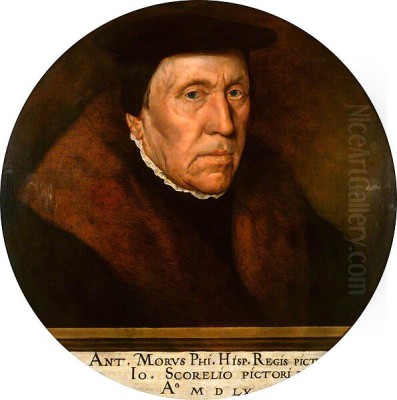
Jan van Scorel stands as a colossus in the art history of the Northern Netherlands. Born in 1495 in the small village of Schoorl, near Alkmaar, and passing away in Utrecht in 1562, his life spanned a period of immense cultural and religious transformation. More than just a painter, Scorel was a polymath – a humanist, cleric, engineer, and arguably the most crucial figure in transmitting the ideals of the Italian High Renaissance to the North. His extensive travels, prestigious appointments, and influential workshop fundamentally reshaped the artistic landscape of his homeland.
Scorel's journey was not merely geographical but intellectual and artistic. He absorbed the groundbreaking developments happening south of the Alps and synthesized them with his native Netherlandish traditions. This fusion resulted in a style that was both innovative and deeply influential, paving the way for subsequent generations of Dutch and Flemish masters. His legacy is cemented not only through his surviving artworks but also through the significant impact he had as a teacher and cultural mediator.
Early Life and Formative Training
Jan van Scorel's origins were somewhat unconventional for the time. He was the illegitimate son of a village priest, a status that required official legitimization later in his life, around 1541. Despite this, he received a solid education, likely beginning at the Latin school in Alkmaar, which provided him with a strong humanist foundation. This early exposure to classical learning would resonate throughout his career, informing his appreciation for the art and culture he would later encounter in Italy.
His formal artistic training began around 1512. While sources sometimes differ on the exact sequence, it's generally accepted that he initially studied with Cornelis Willemsz. in Haarlem. More significantly, he later worked in Amsterdam under Jacob Cornelisz van Oostsanen, a leading painter in the city at that time. However, the most pivotal apprenticeship was arguably with Jan Gossaert (also known as Mabuse) in Utrecht, likely around 1517. Gossaert himself had travelled to Italy and was one of the earliest "Romanists" – Northern artists who incorporated Italianate motifs and classical forms into their work. This encounter undoubtedly fueled Scorel's own desire to experience Italian art firsthand.
The Grand Tour: Germany, Italy, and the Holy Land
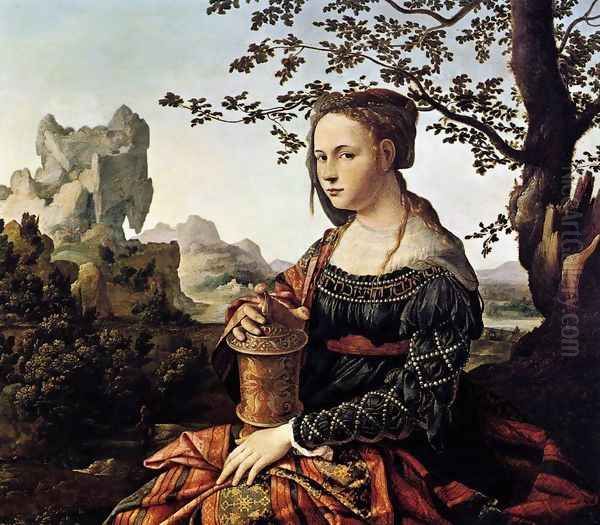
Around 1518 or 1519, Jan van Scorel embarked on an extensive journey that would prove transformative. This was far more than a simple trip; it was a grand tour characteristic of ambitious Northern artists seeking inspiration and knowledge. He travelled through Germany, where he may have encountered the works, if not the person, of Albrecht Dürer in Nuremberg. Dürer's own synthesis of Northern detail and Italian monumentality might have offered an early model for Scorel.
His travels continued through Switzerland and Austria, eventually leading him to Venice around 1520. The vibrant colour and atmospheric light of the Venetian school, particularly the works of Giorgione and perhaps the early Titian or Palma Vecchio, left a discernible mark on his developing palette and handling of paint. Venice, a bustling hub of international trade and culture, exposed him to a different facet of the Italian Renaissance compared to the more form-focused styles of Florence and Rome.
From Venice, Scorel undertook a pilgrimage to the Holy Land. This journey was not merely devotional but also provided him with firsthand experience of the landscapes and settings of biblical narratives. He made sketches and observations that would later inform the backgrounds and details of his religious paintings, lending them an air of authenticity. This experience culminated in a series of portraits of Jerusalem pilgrims upon his return, a unique group portrait type for the era.
The Vatican Appointment: Curator and Court Painter
Scorel's travels eventually led him to Rome, the epicentre of the High Renaissance. Here, he immersed himself in the study of classical antiquity and the masterpieces of contemporary giants like Michelangelo and Raphael. His arrival coincided with a unique historical moment. In 1522, the Utrecht-born Cardinal Adriaan Florensz Boeyens was elected Pope Adrian VI – the only Dutch pope in history and the last non-Italian pope until John Paul II.
Recognizing a talented countryman, Pope Adrian VI appointed Jan van Scorel to two prestigious positions: Inspector of the Papal Collections at the Belvedere, succeeding the recently deceased Raphael, and official court painter. This was an extraordinary opportunity. As curator of antiquities, Scorel had unparalleled access to the Vatican's collection of classical sculptures, including iconic works like the Laocoön and the Apollo Belvedere. This direct engagement with classical art profoundly shaped his understanding of form, anatomy, and idealized beauty.
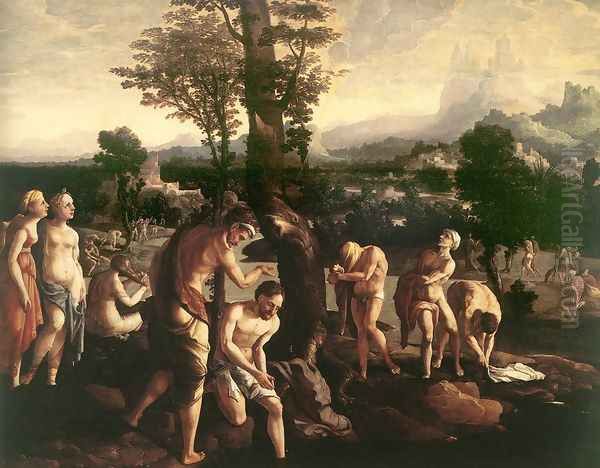
His role as court painter, though brief due to Pope Adrian VI's short reign (he died in 1523), placed Scorel at the very heart of Renaissance patronage. He painted a portrait of the Pope (now lost, but known through copies) and likely undertook other commissions. This period, though short, solidified his absorption of Roman High Renaissance principles – clarity of composition, monumental figures, and graceful movement – which he would soon carry back to the Netherlands.
Return to Utrecht and the Establishment of a Workshop
Following the death of Pope Adrian VI in 1523, Jan van Scorel left Rome and returned to the Netherlands in 1524, settling permanently in Utrecht. Utrecht was a significant ecclesiastical centre, and Scorel quickly established himself as its leading artist. He was appointed a canon of St. Mary's Church (Mariakerk), a position that provided financial stability and social standing, further integrating him into the city's elite circles. This clerical role coexisted with his artistic practice throughout his life.
In Utrecht, Scorel established a large and highly productive workshop. This studio became a major centre for artistic training and production, attracting numerous pupils and assistants. Operating with considerable efficiency, the workshop produced a wide range of works, including altarpieces, devotional paintings, and portraits, catering to both ecclesiastical and private patrons. Scorel would typically handle the design and crucial passages, while assistants worked on backgrounds, drapery, or replicas.
This workshop model was instrumental in disseminating Scorel's style and the principles of the Italian Renaissance throughout the Northern Netherlands. His influence extended beyond his immediate pupils, setting a new standard for artistic ambition and technique in the region. He remained based in Utrecht for the rest of his life, undertaking occasional projects elsewhere but always returning to his adopted city.
Artistic Style: Fusing North and South
Jan van Scorel's artistic style is characterized by its sophisticated synthesis of Italian Renaissance ideals and Northern European traditions. Having absorbed lessons from Gossaert, the Venetians, Raphael, and Michelangelo, he forged a distinct artistic identity. He embraced the Italian emphasis on idealized human figures, classical contrapposto poses, rational perspective, and balanced compositions. His figures often possess a grace and monumentality previously uncommon in Dutch art.
However, Scorel did not simply imitate Italian models. He retained a Northern sensitivity to detail, texture, and light. While his figures are idealized, they often possess a psychological presence and individuality rooted in the Netherlandish portrait tradition. He masterfully employed light and shadow (chiaroscuro) not just for modelling form, but also to create mood and drama, sometimes bathing his scenes in a warm, unifying light reminiscent of his Venetian experience.
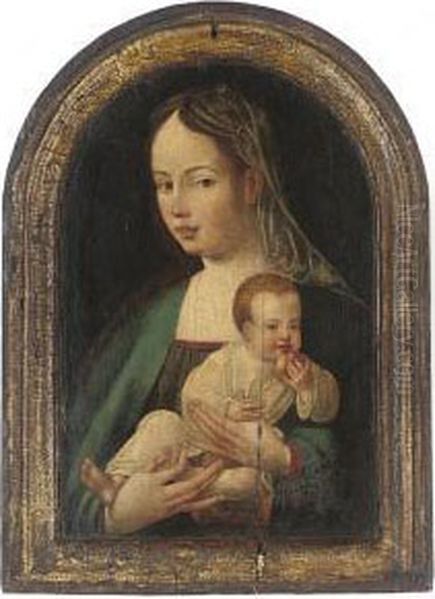
His use of colour was also notable. Influenced by Venice, he often employed rich, saturated hues, harmoniously balanced within the composition. His landscapes, whether depicting the Holy Land or idealized Italianate settings, became integral parts of his narrative paintings, demonstrating a growing interest in landscape for its own sake – a trend that would blossom in later Dutch art. Scorel effectively created a 'Romanist' style that was learned and sophisticated, yet still accessible and appealing to Northern patrons.
Major Themes and Representative Works
Jan van Scorel's oeuvre encompasses religious subjects, mythological scenes (though rarer), and portraiture. Religious narratives and devotional images formed the core of his output, reflecting the demands of his patrons and his own position as a cleric. He painted numerous altarpieces, depictions of the Holy Family, saints, and biblical events.
Among his most celebrated works is the Mary Magdalene (c. 1528-1529), now in the Rijksmuseum, Amsterdam. This painting exemplifies his mature style: the saint is depicted with Raphaelesque grace and idealized beauty, yet possesses a tangible presence and emotional depth. The rich colours, detailed landscape background, and masterful handling of textures showcase his blend of Italian and Northern sensibilities.
The Baptism of Christ (c. 1528-1530), housed in the Frans Hals Museum in Haarlem, is another key work. It features dynamically posed figures, clearly defined anatomical structures inspired by Italian models, and a luminous landscape. The composition is complex yet clear, demonstrating his command of High Renaissance principles.
His Entry of Christ into Jerusalem, part of a larger altarpiece for his church, St. Mary's in Utrecht, further illustrates his ability to handle multi-figure compositions with clarity and narrative force. The series of portraits depicting members of the Haarlem Brotherhood of Jerusalem Pilgrims (c. 1528-1529) are remarkable group portraits, capturing individual likenesses within a commemorative context, set against identifiable views of the Holy Land based on his own travels. Other notable works include various versions of The Virgin and Child and the Head of a Young Scholar. The painting Solomon and the Queen of Sheba also highlights his engagement with Old Testament narratives, rendered with Renaissance grandeur.
Innovations in Portraiture
While adept at religious painting, Jan van Scorel also made significant contributions to the genre of portraiture. He moved beyond the often stiff, purely representational portraits common earlier in the North, infusing his subjects with a greater sense of psychological depth and individual character. His experience in Italy, particularly his exposure to the portraits of Raphael and Venetian artists, informed this approach.
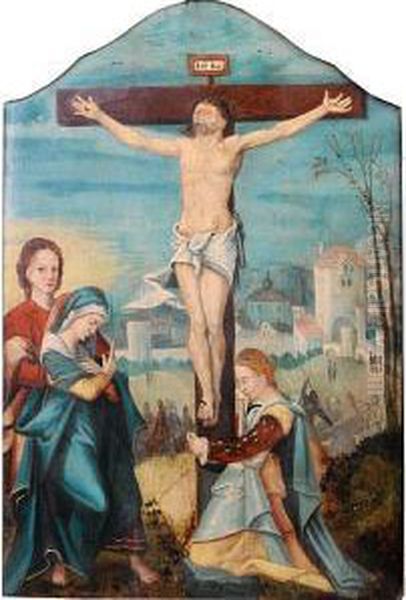
Scorel often placed his sitters in more dynamic poses and frequently included landscape settings or architectural elements in the background, adding context and visual interest. This integration of figure and setting was a notable innovation. His portraits are characterized by careful modelling of the face, capturing subtle expressions, and a keen attention to the textures of clothing and accessories, blending Italianate idealization with Northern realism.
The group portraits of the Jerusalem Pilgrims are particularly innovative, combining individual likenesses with landscape views derived from his own travels, creating a unique blend of portraiture, landscape, and historical documentation. His ability to convey the sitter's status and personality made him a sought-after portraitist among the elite of Utrecht and beyond. This emphasis on psychological insight and the use of evocative backgrounds laid important groundwork for the great flourishing of Dutch portraiture in the following century, influencing artists like his own pupil Antonis Mor.
The Teacher: Nurturing the Next Generation
Jan van Scorel's influence extended significantly through his role as a teacher. His Utrecht workshop was arguably the most important training centre for artists in the Northern Netherlands during the second quarter of the 16th century. He attracted talented pupils eager to learn the modern, Italianate style he championed.
His most famous pupil was undoubtedly Maarten van Heemskerck (1498-1574). Heemskerck worked with Scorel, likely in Haarlem for a period around 1527-1529 before Scorel settled permanently in Utrecht, and absorbed his master's style before embarking on his own journey to Rome. Heemskerck became a leading figure of Northern Mannerism, further developing the Romanist tradition. The relationship, however, also contained elements of rivalry, particularly later in their careers.
Another highly significant pupil was Antonis Mor van Dashorst (c. 1517-1577), better known internationally as Antonio Moro. Mor became one of the most successful and sought-after court portraitists in Europe, working for the Habsburgs in Spain, Portugal, England, and the Netherlands. While Mor developed his own distinct, somewhat more austere style, the foundation in anatomical accuracy, psychological insight, and refined technique learned in Scorel's workshop was crucial to his success. Scorel's teaching, therefore, directly shaped the careers of two of the most important Netherlandish artists of the mid-16th century.
Contemporaries: Collaboration and Competition
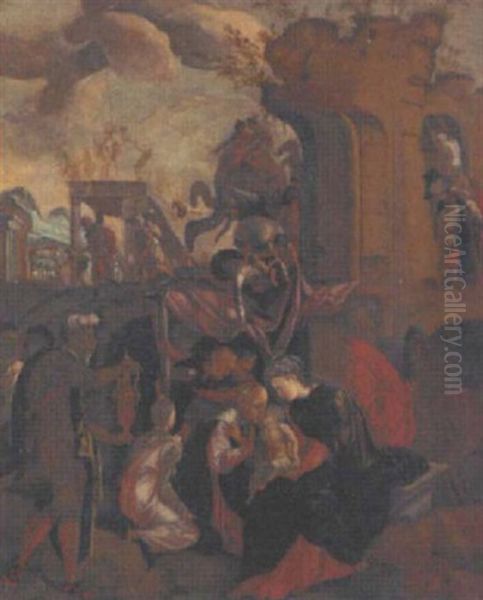
The art world of the 16th-century Netherlands was relatively small, and artists often knew each other, sometimes collaborating, sometimes competing. Scorel's primary teacher, Jan Gossaert, remained an important figure in the early part of Scorel's career. Scorel would also have been aware of the work of other leading Netherlandish artists like Lucas van Leyden, known for his prints and paintings, and perhaps Bernard van Orley in Brussels.
His relationship with Maarten van Heemskerck was particularly complex. Initially Scorel's pupil and perhaps assistant, Heemskerck quickly emerged as a major artist in his own right. They worked in Haarlem around the same time in the late 1520s. Later, they became direct competitors for major commissions, particularly for large altarpieces in the 1530s and 1540s. While both were proponents of Romanism, their styles diverged, with Heemskerck embracing a more exaggerated, Mannerist aesthetic after his own trip to Rome.
Scorel's international travels and Vatican connections also put him in a unique position relative to his contemporaries. He had direct experience of the Italian masters – Michelangelo, Raphael, Giorgione, Titian – that few Northern artists of his generation possessed. This gave his work an authority and sophistication that set him apart and fueled his influence. He was a central node in the network of artistic exchange between Italy and the North, alongside other Romanists like Lambert Lombard from Liège.
Beyond Painting: Engineer and Architect
Jan van Scorel's talents were not confined to painting. Reflecting the Renaissance ideal of the universal man, he also engaged in architecture and engineering projects. While documentation for these activities is less extensive than for his paintings, his involvement is confirmed. His humanist education likely included geometry and principles of architecture, which he applied practically.
He is known to have designed the elaborate wooden rood screen and possibly the pulpit for his church, St. Mary's in Utrecht (destroyed during later iconoclasm). This demonstrates his ability to work in three dimensions and integrate artistic design with structural requirements. There are also records suggesting his involvement in hydraulic engineering projects, such as dike repairs and polder management – vital activities in the low-lying Netherlands.
This versatility underscores Scorel's broad intellectual curiosity and practical skills. His ability to work across disciplines enhanced his status and influence. It also suggests that his workshop training may have included elements of design and perhaps even architectural drawing, providing his students with a broader skill set. His role as a canon likely facilitated his involvement in church-related building and design projects.
Personal Life and the Turbulent Times
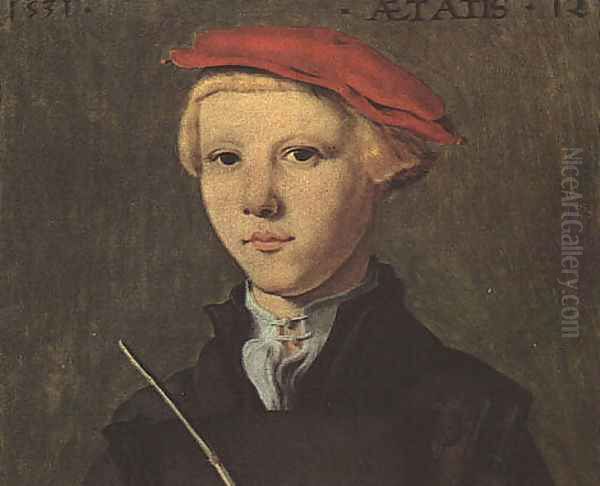
Scorel lived through a period of profound religious upheaval – the Protestant Reformation. While the Northern Netherlands would eventually become predominantly Calvinist, Utrecht remained a Catholic stronghold for longer, and Scorel himself remained a devout Catholic and cleric throughout his life. However, the tensions and debates of the era inevitably impacted the world around him and the nature of religious patronage. Some scholars detect subtle reflections of the era's spiritual intensity or anxieties in his later works.
His personal life had its complexities. The fact of his illegitimate birth was a significant social factor, eventually rectified by official papal legitimization in 1541. Records also indicate a long-term relationship with a mistress, Agatha van Schoonhoven. It's plausible, as suggested by early biographer Karel van Mander, that she served as a model for some of his female figures, perhaps including the famous Mary Magdalene. Such relationships were not uncommon, even among clergy, in the period before the Council of Trent enforced stricter clerical discipline.
These personal details provide a glimpse into the man behind the art, living and working within the social norms and contradictions of his time. He successfully navigated his clerical duties and his artistic career, achieving prominence and respect in both spheres despite the era's challenges and his own unconventional background.
Enduring Influence and Legacy
Jan van Scorel's death in Utrecht in 1562 marked the end of a remarkably influential career. His primary legacy lies in his successful importation and adaptation of Italian High Renaissance ideals to the Northern Netherlands. He provided a crucial bridge between the late Gothic traditions of the North and the new artistic language emerging from Italy. His work demonstrated how classical forms, anatomical accuracy, perspective, and idealized beauty could be integrated with Northern preferences for detail, texture, and emotional expression.
His influence was disseminated primarily through his highly successful workshop and his prominent students, Maarten van Heemskerck and Antonis Mor. Heemskerck carried the Romanist torch into the realm of Mannerism, influencing artists in Haarlem for decades. Mor established an international model for court portraiture that resonated across Europe. Scorel's emphasis on landscape within narrative and portrait painting also contributed to the eventual emergence of landscape as an independent genre in Dutch art, a path further explored by artists like Pieter Bruegel the Elder, who also travelled to Italy shortly after Scorel's era.
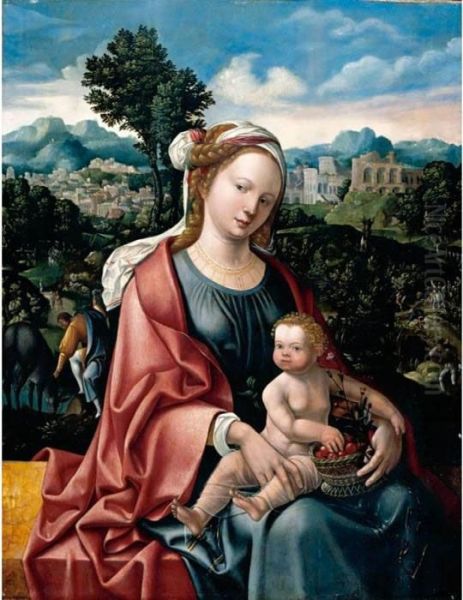
Even artists who did not directly study with him felt his impact. He set a new benchmark for artistic sophistication and ambition in Utrecht and beyond. His ability to synthesize diverse influences – Venetian colour, Roman form, Northern detail – created a powerful and adaptable style that shaped the course of Dutch art for much of the 16th century. He remains a pivotal figure, essential for understanding the transition from the late Gothic to the Renaissance in Northern Europe.
Conclusion: A Bridge Between Worlds
Jan van Scorel was more than a painter; he was a cultural conduit, a learned humanist, a dedicated cleric, and an influential teacher. His life and work exemplify the dynamic exchanges that characterized the Renaissance. Through his extensive travels, his prestigious Vatican appointment, and his thriving Utrecht workshop, he fundamentally altered the trajectory of art in the Northern Netherlands. He absorbed the lessons of the Italian masters – Raphael, Michelangelo, Giorgione – and translated them into a visual language that resonated with his Northern contemporaries and patrons.
His paintings, from the graceful Mary Magdalene to the evocative Jerusalem Pilgrim portraits, showcase a masterful blend of Southern idealism and Northern realism. He elevated portraiture, enriched religious narratives, and contributed to the development of landscape painting. Through his students, particularly Heemskerck and Mor, his influence extended across genres and geographical borders. Jan van Scorel remains a cornerstone figure, the artist who decisively brought the light of the Italian Renaissance to the Dutch artistic landscape.